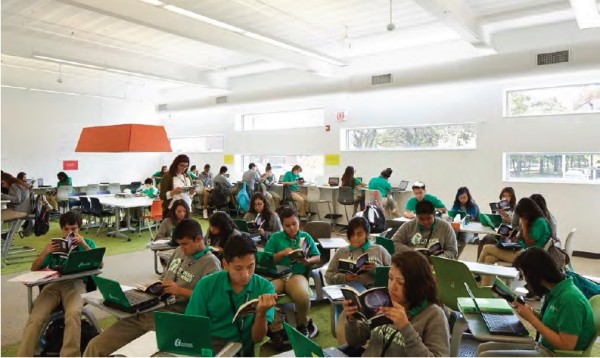
Blended learning is beginning to change the way schools are run, and even the way they’re built. But Florida schools may be hamstrung by building codes, class-size penalties and outdated teacher-preparation programs, members of a state House panel said Thursday.
“I think our role is to get the roadblocks out of the way,” said Rep. Manny Diaz, R-Hialeah, who chairs the House education panel on school choice and innovation.
The panel heard from Michael Horn of Clayton Christensen Institute, who has studied blended learning around the country. He told the panel via Skype that combining virtual education with in-person instruction can allow students to learn at their own pace, and give educators more flexibility.
School buildings designed with blended learning in mind often include open floor plans that cost less to build, slash energy costs and create more engaging learning environments, Horn said. They also lend themselves to different staffing models. In some cases, he said, teachers eschew traditional classes and work together in teams, allowing experienced “master teachers” to work with larger numbers of students.
When Horn showed pictures of Chicago-based Intrinsic Schools, Rep. Janet Adkins, R-Fernandina Beach, questioned whether their designs would even fly in Florida.
“It looks like this would exceed the class size,” she said, referring to the state constitutional amendment passed in 2002 that capped the number of students allowed per classroom. “It’s striking as you look at all these pictures.”
Class-size limits and other rules haven’t stifled innovation completely. Experiments like Miami-Dade Public Schools’ iPrep Academy and Florida Virtual School’s blended learning labs have gotten some attention in national education media.
The problem, Horn said, is schools have long been regulated based on “inputs” like building designs and teacher ratios — a problem in no way confined to Florida. That, he said, “by definition constrains innovation.”
“If you were to tell me to host a dinner party and make an innovative meal, but I could only use these ingredients in these combinations, I would come out with the exact recipe you had just given me,” he said. Instead, policies should focus on “empowering teachers and administrators on the ground, but really focusing on the individual student learning outcomes.”
Diaz said lawmakers might revisit proposals that would ease class-size penalties for districts and give schools more freedom under state construction rules. The question, he said, is: “How do we open it up so that the market can take care of itself — our public schools, our charter schools, all these other models?”
Rep. Elizabeth Porter, R-Lake City, wanted to know whether any universities were preparing teachers for blended-learning schools.
Horn said with few exceptions, teachers are still trained in traditional methods, and have to adjust on the fly after they’re hired.
“They figure it out over time in these models, from what I’ve seen… but that’s a terrible place to be putting schools and teachers in,” he said.


